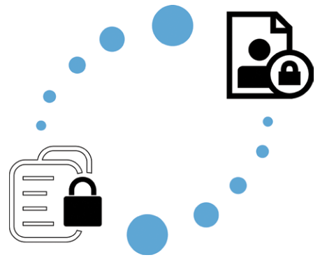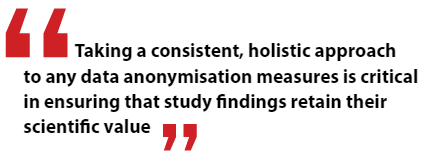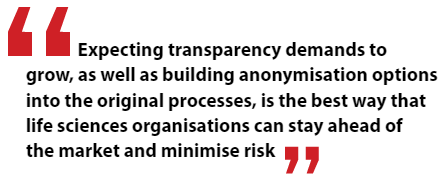Protecting Patient Identities
From November 2016, new EMA guidance specifies that clinical study reports must be given new treatment to ensure that subjects’ identities are not put at risk, as companies meet the demand for greater transparency around their research processes and results. What is the most effective approach?
Life sciences organizations are under growing pressure to become more open about their clinical trial data, as part of an intensified focus on improving transparency in the industry. Study subjects are, understandably, keen to learn the results of trials they have taken part in, and research peers and the wider public also have an interest in outcomes, as reflected in the new requirements for lay summaries. Many leading pharma companies have already developed their own responses to the trend, but now the EMA is moving towards a formal policy for clinical trial reporting – EMA Policy 0070, which it drafted two years ago. Earlier this year, the EMA issued extensive implementation guidance, which it expects firms to comply with from this November.
Under the new legislation, clinical study reports (CSRs) must be made available within 60 days of an authorization decision – positive or otherwise – in a format that removes any risk of a subject’s identity being breached (redaction, the current method, will not be acceptable). The deadline has come around quickly, producing something of a knee-jerk reaction in organizations that had not yet developed a process that could help meet this requirement. The temptation for many has been to concentrate on the immediate need – for instance, to create a system that takes care of CSR documents specifically, reliably sanitizing them so that they do not inadvertently give away any participant’s identity. Some of these firms, however, have run into problems with this approach.
Although the EMA has started out with CSRs as its target, it is unlikely to be the sole source of focus for anonymizing subject references. Indeed, the published policy document indicates that it is only a matter of time before all the patient-level data behind those reports will need to be given the same treatment. This necessitates a more holistic view of patient anonymization – one that begins with the underlying patient-level data. Since everything else flows from that, it makes sense to start from this point. Being consistent and systematic from the outset has the potential to save a lot of time, expense and risk across the board as the EMA’s outlook broadens.
Safeguarding Data
Taking a consistent, holistic approach to any data anonymization measures is critical in ensuring that study findings retain their scientific value. If life sciences firms develop one type of process or a particular algorithm for anonymizing CSRs and another for different documents or data, it could become very difficult to re-join the dots if researchers later need to perform further cross-referencing and analysis. This might undermine the broader value of the data, and could introduce risk to any wider conclusions that are drawn  afterwards from the source results.
afterwards from the source results.
Adopting a new level of complexity may also create more work for companies further down the line, as they are obligated to address follow-on queries once clinical trial findings are in the public domain. It could mean additional administrative tasks, like tying up precious resources for instance. Ideally, interested parties should be able to find all the answers they require online.
The EMA may have concluded that making CSR the initial focus would make lighter work for organizations in the early stages of adapting to the new demands around clinical trial transparency, shielding companies from the need to worry about the technicalities of thousands of data fields that might be associated with broader data anonymization. Concerned about the mounting time pressure, some life sciences businesses have turned to external agencies to process CSR documents, however. As noted before, electronic redaction – the equivalent of drawing a thick black line through patient information – is not permitted by the new guidance. Rather, strict formulae need to be applied to protect Patient A’s identity – which could be open to discovery based on the type of study they took part in, their age, race and demographic, and when they attended the hospital or clinic, among other pieces of information in their clinical data record.

Meanwhile, using offshore resources to clear the backlog has produced its own issues. In some cases, there have been questions about quality, leading to some processing having to be redone. Furthermore, given that a typical application for marketing authorization may comprise of 50 separate studies, keeping track of the different formulae that have been used to protect patients’ identities is creating a different set of concerns.
Cutting Corners
Starting with the original data promises to be more economical in the long term; it is more reliable, and means that firms could prepare compliant, anonymized CSRs so that these are ready on the shelves at the time of marketing authorization submission. It seems a much better approach all round, even if time is pressing on now.
Focusing only on the initial requirements of the EMA guidance is understandable, but it could lead to more work and costs in the long run. This is something certain pharma companies are already starting to notice, as their current piecemeal approaches to the challenge begin to struggle. Another sign of this is that some organizations are thinking about rerunning reports – that is, redoing all their analyses and recreating study reports using compliant, anonymized patient references. The fact that they are even considering a non-trivial undertaking of this nature, which adds no conceivable value to the business, confirms the lack of real strategy across the industry.
If companies understood how much simpler and less painful the clinical trial anonymization process would be if they harnessed the right tools and started in the right place, they could avoid much of this stress. Because patient-level data are structured and well-organized, any transformations are easily manageable, as this can be done systematically and comprehensively in a few effortless steps. Once they have found their stride, businesses can expect to process an entire clinical study’s worth of data in just a day; and once the master data has been given the anonymization treatment, amending the study reports becomes a simple matter of intelligent search and replace – the hard work has already been done. The overall investment is not much different than doing things the right way first time, but the long-term gains are substantial. We should not forget that the EMA will demand fuller data anonymization before too long; the CSR-only requirement is just a temporary step. There is, therefore, no way to avoid this. Beginning with the data is a much safer and more methodical way to go about patient anonymization. It simultaneously makes it easier to ultimately anonymize the CSR, while reducing the likelihood that external parties will discover inconsistencies in the public reports and data that cause them to get in touch.
One Step Ahead
Expecting transparency demands to grow, as well as building anonymization options into the original processes, is the best way that life sciences organizations can stay ahead of the market and minimize risk. Although the FDA is not committing itself to the path the EMA has taken, it is conceivable that this will change down the line, so there is no justification for complacency in whichever markets these firms are operating today.

The requirement to produce lay language summaries for making clinical trial findings more accessible to the general public is a further indication of how important data sharing has become in life sciences. In this age of digital connectivity and growing consumer consciousness, populations are exercising their right to know more about the studies in which they are participating, the products they are buying and the processes behind them. If not the case already, it will soon reach a point where companies that do not share their data risk being put into the spotlight, prompting consumers to wonder what they are trying to hide.
Patient privacy will always be of paramount importance, so the industry needs to find a middle ground between compliance and patient safeguarding, and the advances and promotion of science. With the right measures in place, life sciences firms should not have to worry about the risk posed by greater transparency. Rather, their concern should be about meeting a reasonable expectation of risk management – one that does not sacrifice science by stripping the value out of the data.
Long-Term Gain
It is important to keep in mind the spirit and wider purpose of the policy – to disseminate knowledge and to empower external communities to find the answers they need more readily – so that the benefits of research and of medicinal advances have the broadest possible reach. Embracing this aspiration and making the extra effort to deliver against its core values is a worthwhile position for pharma organizations to assume. At the very least it looks good, and it is a strategy that could pay dividends in the long run.


